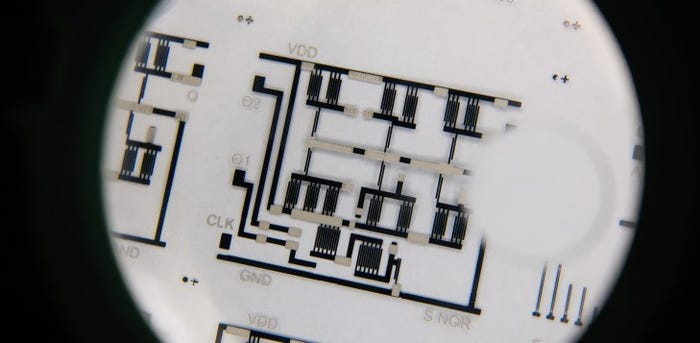Using a T-Shirt Printer to Make Medical Circuits
November 18, 2014
Researchers in Singapore have managed to print sophisticated electronic circuits with a T-shirt printer. The circuits' resistors, transistors, and capacitors are made using nontoxic materials such as silver nanoparticles, carbon, and plastics. The circuits can be deposited on a range of materials, including common ones including paper, plastic, and aluminum foil.
Led by printed electronics expert Joseph Chang, a Nanyang Technological University professor, the research could be used for a broad spectrum of applications including health monitoring. In the future, inexpensive electronics could be embedded into bandages to monitor wound healing, and wearable electronic patches could monitor vital signs. The researchers have also patented Internet of Things-powered medication adherence applications.
The technology also could be used to affix low-cost electronics onto consumer goods to monitor the expiration date.
|
Complex electronic circuits can be printed onto flexible materials like the transparent plastic sheet shown here. (Image courtesy of Nanyang Technological University.) |
The method could be used to potentially to make circuits quickly and inexpensively. The entire process takes a matter of minutes. And the cost of the method is said to be so negligible that the electronics could be disposed of after use. In addition, the process used to make the circuits is completely additive. According to the researchers, the materials are all nontoxic. (Although, the safety profile of silver nanoparticles is uncertain.)
"We are not competing with high-end processors like those found in smartphones and electronic devices," Chang said in a statement. "Instead we complement them with cheaply printed circuits that cost mere cents instead of a few dollars, making disposable electronics a reality."
Biomedical and lighting applications are among the first applications targeted by the research team, which includes two engineers, a materials scientist, and a chemist.
A startup company has been set up to commercialize the technology, which has attracted interest from a venture capitalist and a prominent biomedical company, according to the press release.
Refresh your mobile health knowledge at BIOMEDevice San Jose, December 3-4, 2014. |
Brian Buntz is the editor-in-chief of MPMN and Qmed. Follow him on Twitter at @brian_buntz.
Like what you're reading? Subscribe to our daily e-newsletter.
About the Author(s)
You May Also Like


